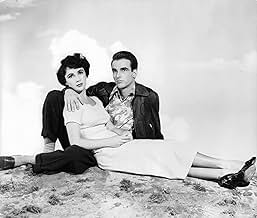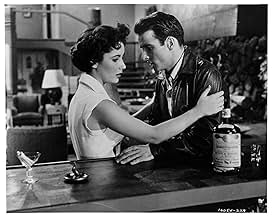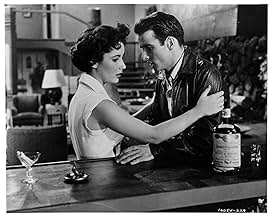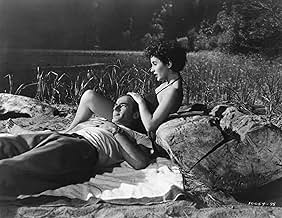CALIFICACIÓN DE IMDb
7.7/10
26 k
TU CALIFICACIÓN
Un niño pobre consigue un trabajo para su tío rico que termina enamorándose de dos mujeres.Un niño pobre consigue un trabajo para su tío rico que termina enamorándose de dos mujeres.Un niño pobre consigue un trabajo para su tío rico que termina enamorándose de dos mujeres.
- Dirección
- Guionistas
- Elenco
- Ganó 6 premios Óscar
- 18 premios ganados y 12 nominaciones en total
Robert J. Anderson
- Eagle Scout
- (sin créditos)
Gertrude Astor
- Bit Part
- (sin créditos)
Opiniones destacadas
A Place in the Sun (1951)
**** (out of 4)
Oscar-winning tale of a poor boy (Montgomery Clift) who goes to work for his uncle hoping to one day be rich like him. He falls in love with a small time woman (Shelley Winters) but soon gets a taste of the society life with a beauty (Elizabeth Taylor) and this is the start of his downfall. A PLACE IN THE SUN went home with six Oscars including Best Director for George Stevens and it's easy to see why he took home the award because there's so much going on in this picture yet he holds it together perfectly. The film is part melodrama, part message film, part romance and part suspense and Stevens really brings all of it together so perfectly that you can't help but get drawn into the story and feel every bit of pain that the characters do. The most amazing thing for me, and I'm not sure if it was meant to happen this way, but I really felt a lot of sympathy for the Clift character. Again, I'm not sure if this was the filmmakers intent but no matter how much I disagreed with what he was doing at the same time I never once hated him and even to the end I was hoping things would turn his way. I think some of this credit should be given to Clift who once again turns in a remarkable performance. I thought the shyness early on, the romance with Taylor and the hatred that someone is going to take away his dreams are all things that Clift perfectly nailed. The sequence on the boat towards the end is something masterfully performed by the actor. Taylor is also extremely good in her part even though of all the main characters I think hers is the most underwritten. Winters is also very good in her role of the woman who finds herself being left behind for someone better. I thought all the scenes between her and Clift, be it romantic or fighting, were full of wonderful chemistry. Anne Revere is a standout as Clift's mother and Raymond Burr is good in his few scenes. Again, a lot of credit has to go to Stevens because every aspect of the film works. The early love story between Clift and Shelley works. The love story between Clift and Taylor works. The downright suspense on the boat at night works. Even the ending manages to work. A PLACE IN THE SUN deserves its place as an all-time classic.
**** (out of 4)
Oscar-winning tale of a poor boy (Montgomery Clift) who goes to work for his uncle hoping to one day be rich like him. He falls in love with a small time woman (Shelley Winters) but soon gets a taste of the society life with a beauty (Elizabeth Taylor) and this is the start of his downfall. A PLACE IN THE SUN went home with six Oscars including Best Director for George Stevens and it's easy to see why he took home the award because there's so much going on in this picture yet he holds it together perfectly. The film is part melodrama, part message film, part romance and part suspense and Stevens really brings all of it together so perfectly that you can't help but get drawn into the story and feel every bit of pain that the characters do. The most amazing thing for me, and I'm not sure if it was meant to happen this way, but I really felt a lot of sympathy for the Clift character. Again, I'm not sure if this was the filmmakers intent but no matter how much I disagreed with what he was doing at the same time I never once hated him and even to the end I was hoping things would turn his way. I think some of this credit should be given to Clift who once again turns in a remarkable performance. I thought the shyness early on, the romance with Taylor and the hatred that someone is going to take away his dreams are all things that Clift perfectly nailed. The sequence on the boat towards the end is something masterfully performed by the actor. Taylor is also extremely good in her part even though of all the main characters I think hers is the most underwritten. Winters is also very good in her role of the woman who finds herself being left behind for someone better. I thought all the scenes between her and Clift, be it romantic or fighting, were full of wonderful chemistry. Anne Revere is a standout as Clift's mother and Raymond Burr is good in his few scenes. Again, a lot of credit has to go to Stevens because every aspect of the film works. The early love story between Clift and Shelley works. The love story between Clift and Taylor works. The downright suspense on the boat at night works. Even the ending manages to work. A PLACE IN THE SUN deserves its place as an all-time classic.
I can only say that George Stevens' version of Theodore Dreiser's "An American Tragedy" is not what I envisioned when I read the book. Therefore, I came away disappointed at the screen treatment with Liz Taylor (beautiful but shallow), Montgomery Clift (beautiful but shallow) and poor Shelley Winters looking like a drab little wren. An air of artificiality hangs over every scene, every slow-moving scene, and only increases by the time the story arrives at the courtroom climax where an unrestrained Raymond Burr is allowed to chew the scenery.
This is NOT the great picture everyone always says it is. It's one of those films that dates badly. Evidently, fans of Liz Taylor and Monty Clift are starry-eyed about their favorite actors and refuse to see the weaknesses in the plodding story and the thinly sketched characters. Elizabeth Taylor had much better roles in her future career (Cat On a Hot Tin Roof, Giant) and Montgomery Clift would make an unforgettable Morris Townsend in The Heiress. Their acting here is as self-conscious as the arty camerawork that frames them in huge romantic close-ups.
The novel had much more depth and meaning than this watered down version of the story. Read it and you will wonder what all the fuss was about when "A Place in the Sun" was released. Vastly overrated and noteworthy only for the sincere performance of Shelley Winters and Franz Waxman's interesting background score.
This is NOT the great picture everyone always says it is. It's one of those films that dates badly. Evidently, fans of Liz Taylor and Monty Clift are starry-eyed about their favorite actors and refuse to see the weaknesses in the plodding story and the thinly sketched characters. Elizabeth Taylor had much better roles in her future career (Cat On a Hot Tin Roof, Giant) and Montgomery Clift would make an unforgettable Morris Townsend in The Heiress. Their acting here is as self-conscious as the arty camerawork that frames them in huge romantic close-ups.
The novel had much more depth and meaning than this watered down version of the story. Read it and you will wonder what all the fuss was about when "A Place in the Sun" was released. Vastly overrated and noteworthy only for the sincere performance of Shelley Winters and Franz Waxman's interesting background score.
This 1950s melodrama was an interesting, involving story. It's part film-noir, too, which I liked. I say that because the last third of the film featured an expectation of some dreaded act about to be committed, giving it a film noir feel.
One thing for sure, whatever you label the movie: it's well-acted, well-directed and well-photographed. Regarding the latter, this really looks good on DVD. No surprise it's directed well since George Stevens was the director. His resume speaks for itself.
Obviously Montgomery Clift and Elizabeth Taylor are the "big names" in this film, but I found Shelly Winters and the character she played to be the most intriguing. She wasn't really appealing yet one could certainly identify with her feelings of insecurity with Taylor as her competition. "Liz" was in in her prime, looks-wise, with an absolutely classic face.
Anyway, watching the character studies of the antsy Winters and the troublesome Clift were interesting. Clift, as is the case with most of us, causes his own problems and things slowly unravel for him. The story is another example of what can happen when one tries to cover up the truth. It comes back to bite you, big-time!
I really found it refreshing, however, to see Clift's attitude at the end. It's the exact opposite of what you hear today. He actually takes responsibility for his actions.
One thing for sure, whatever you label the movie: it's well-acted, well-directed and well-photographed. Regarding the latter, this really looks good on DVD. No surprise it's directed well since George Stevens was the director. His resume speaks for itself.
Obviously Montgomery Clift and Elizabeth Taylor are the "big names" in this film, but I found Shelly Winters and the character she played to be the most intriguing. She wasn't really appealing yet one could certainly identify with her feelings of insecurity with Taylor as her competition. "Liz" was in in her prime, looks-wise, with an absolutely classic face.
Anyway, watching the character studies of the antsy Winters and the troublesome Clift were interesting. Clift, as is the case with most of us, causes his own problems and things slowly unravel for him. The story is another example of what can happen when one tries to cover up the truth. It comes back to bite you, big-time!
I really found it refreshing, however, to see Clift's attitude at the end. It's the exact opposite of what you hear today. He actually takes responsibility for his actions.
The young and poor George Eastman (Montgomery Clift) leaves his religious mother and Chicago and arrives in California expecting to find a better job in the business of his wealthy uncle Charles Eastman (Herbert Heyes). His cousin Earl Eastman (Keefe Brasselle) advises him that there are many women in the factory and the basic rule is that he must not hang around with any of them.
George meets the worker of the assembly line Alice Tripp (Shelley Winters) in the movie theater and they date. Meanwhile, the outcast George is promoted and he meets the gorgeous Angela Vickers (Elizabeth Taylor) in a party at his uncle's house. Angela introduces him to the local high society and they fall in love with each other. However, Alice is pregnant and she wants to get married with George. During a dinner party at Angela's lake house with parents, relatives and friends, Alice calls George from the bus station and gives thirty minutes to him to meet her; otherwise she will crash the party and tells what has happened. George is pressed by the situation that ends in a tragedy.
"A Place in the Sun" is an unforgettable masterpiece by George Stevens and one of the best love stories ever made, with the perfect development of characters and situations. I watched this film for the first time on 14 June 2001 on cable television and yesterday I saw it again on a Paramount DVD with Extras telling details about the difficulties that George Stevens faced to bring Theodore Dreiser's novel "An American Tragedy" to a motion picture and casting. He had to sue Paramount to carry out the signed contract and get the agreed budget. Another interesting point is Shelley Winters, who was a sex symbol at that time, telling how she got the role of Alice Tripp. Elizabeth Taylor also tells funny things about her relationship with Montgomery Cliff. My vote is ten.
Title (Brazil): "Um Lugar Ao Sol" ("A Place in the Sun")
George meets the worker of the assembly line Alice Tripp (Shelley Winters) in the movie theater and they date. Meanwhile, the outcast George is promoted and he meets the gorgeous Angela Vickers (Elizabeth Taylor) in a party at his uncle's house. Angela introduces him to the local high society and they fall in love with each other. However, Alice is pregnant and she wants to get married with George. During a dinner party at Angela's lake house with parents, relatives and friends, Alice calls George from the bus station and gives thirty minutes to him to meet her; otherwise she will crash the party and tells what has happened. George is pressed by the situation that ends in a tragedy.
"A Place in the Sun" is an unforgettable masterpiece by George Stevens and one of the best love stories ever made, with the perfect development of characters and situations. I watched this film for the first time on 14 June 2001 on cable television and yesterday I saw it again on a Paramount DVD with Extras telling details about the difficulties that George Stevens faced to bring Theodore Dreiser's novel "An American Tragedy" to a motion picture and casting. He had to sue Paramount to carry out the signed contract and get the agreed budget. Another interesting point is Shelley Winters, who was a sex symbol at that time, telling how she got the role of Alice Tripp. Elizabeth Taylor also tells funny things about her relationship with Montgomery Cliff. My vote is ten.
Title (Brazil): "Um Lugar Ao Sol" ("A Place in the Sun")
George Eastman takes up friendly offer from his uncle to go work in the highly prosperous Eastman bathing-suit factory. Formerly a bell hop at a hotel, and born out of a relatively poor, but religiously devout home, George is spellbound by how the upper crust live. As he starts to climb the social ladder he becomes besotted with his cousin's beautiful partner, Angela Vickers. While at the same time neglecting his girlfriend and mother of his unborn child, Alice Tripp. The outcome of George's confused emotions will have devastating effects on everyone involved...
A Place In The Sun is one of those revered, yet seemingly divisive classic pictures that I believe deserves every bit of praise heaped upon it. Based on the Theodore Dreiser novel, An American Tragedy {and the Patrick Kearney play}, it's a slow simmering piece that boasts technical greatness and a class division script that is intriguingly shrouded by a real life sad story. The book and subsequent film versions {Josef von Sternberg filmed an adaptation in 1931} are working from the real case of Chester Gillette and his girlfriend, Grace Brown. To expand further would result in major spoilers but it's a case that is readily available to anyone with internet access. Here with this adaptation, director George Stevens {sublime direction} has gathered all the things available to him and crafted a Gothic, almost dreamy, classic amongst classics. The source, and Sternberg's take on the novel may well be more stark and grimly oppressive, but this has such high cinema values it positively begs you to invest your very being with it.
The story behind the scenes is itself worthy of a movie, Stevens clashing constantly with Montgomery Clift {Eastman} and Shelley Winters {Tripp}, Clift because he would only take motivation from his personal coach, Mira Rostova, and Winters because Stevens had never wanted her cast in the first place! Then there is the Elizabeth Taylor {Angela Vickers} factor, blissfully unaware of Clift's burgeoning homosexuality, she reciprocated Clift's adoration of her by falling for him big time, the results, all captured by Stevens, are akin to being put under a spell that you simply can't turn away from. Montgomery Clift was one of the best actors of his generation, here in spite of a secretly confused emotional state, the sparks that ping off Taylor and himself are the kind that few lauded chemistry couples in movie history have ever gotten close too. Monty Clift is worth every penny or cent that is spent to watch him perform, here is yet another performance of emotional oomph to only confirm his standing as a true giant of American actors.
Academy Awards went to Best Director, Best Screenplay {Michael Wilson & Harry Brown}, Best Cinematography {William Mellor}, Best Costume Design {Edith Head}, Best Editing {William Hornbeck} and Best Score {Franx Waxman}, all of them deserved, with Waxman's score one of the true greats of 50s cinema, a character in itself and something to totally lose yourself in. Clift & Winters were both nominated in the Best actor/Actress categories respectively, and really in any other year they surely would have won, while the film itself was also nominated for Best Film. Ultimately it's the story itself that makes A Place In The Sun such a beguiling viewing, it's love divided by classes, no middle ground here, it's the rich and beautiful on one side, on the other is the plain and poor, the result is a majestic piece of cinema. 10/10
A Place In The Sun is one of those revered, yet seemingly divisive classic pictures that I believe deserves every bit of praise heaped upon it. Based on the Theodore Dreiser novel, An American Tragedy {and the Patrick Kearney play}, it's a slow simmering piece that boasts technical greatness and a class division script that is intriguingly shrouded by a real life sad story. The book and subsequent film versions {Josef von Sternberg filmed an adaptation in 1931} are working from the real case of Chester Gillette and his girlfriend, Grace Brown. To expand further would result in major spoilers but it's a case that is readily available to anyone with internet access. Here with this adaptation, director George Stevens {sublime direction} has gathered all the things available to him and crafted a Gothic, almost dreamy, classic amongst classics. The source, and Sternberg's take on the novel may well be more stark and grimly oppressive, but this has such high cinema values it positively begs you to invest your very being with it.
The story behind the scenes is itself worthy of a movie, Stevens clashing constantly with Montgomery Clift {Eastman} and Shelley Winters {Tripp}, Clift because he would only take motivation from his personal coach, Mira Rostova, and Winters because Stevens had never wanted her cast in the first place! Then there is the Elizabeth Taylor {Angela Vickers} factor, blissfully unaware of Clift's burgeoning homosexuality, she reciprocated Clift's adoration of her by falling for him big time, the results, all captured by Stevens, are akin to being put under a spell that you simply can't turn away from. Montgomery Clift was one of the best actors of his generation, here in spite of a secretly confused emotional state, the sparks that ping off Taylor and himself are the kind that few lauded chemistry couples in movie history have ever gotten close too. Monty Clift is worth every penny or cent that is spent to watch him perform, here is yet another performance of emotional oomph to only confirm his standing as a true giant of American actors.
Academy Awards went to Best Director, Best Screenplay {Michael Wilson & Harry Brown}, Best Cinematography {William Mellor}, Best Costume Design {Edith Head}, Best Editing {William Hornbeck} and Best Score {Franx Waxman}, all of them deserved, with Waxman's score one of the true greats of 50s cinema, a character in itself and something to totally lose yourself in. Clift & Winters were both nominated in the Best actor/Actress categories respectively, and really in any other year they surely would have won, while the film itself was also nominated for Best Film. Ultimately it's the story itself that makes A Place In The Sun such a beguiling viewing, it's love divided by classes, no middle ground here, it's the rich and beautiful on one side, on the other is the plain and poor, the result is a majestic piece of cinema. 10/10
¿Sabías que…?
- TriviaIn her autobiography, Shelley Winters described producer and director George Stevens' way of working: "He would discuss the scene, but not the lines, and would photograph the second or third rehearsal so the scene had an almost improvisatory quality. Stevens would print the first take, then spend the next three hours minutely rehearsing the scene, then film it again. He explained to me that in this way he often got actors' unplanned reactions that were spontaneous and human and often exactly right. And often when actors overintellectualize or plan their reactions, they aren't as good."
- ErroresAlice Tripp is wearing different shoes when she starts walking home from the movie with George Eastman from those she is wearing when they near her residence. When Shelley Winters pointed out to director George Stevens that the brown and white shoes she was wearing turned to black when she walked around the corner, the director refused to re-shoot the scene. According to Winters, he said, "If they're looking at her feet, I can go home."
- ConexionesFeatured in Hollywood: The Fabulous Era (1962)
Selecciones populares
Inicia sesión para calificar y agrega a la lista de videos para obtener recomendaciones personalizadas
Detalles
Taquilla
- Presupuesto
- USD 2,295,304 (estimado)
- Total a nivel mundial
- USD 18,247
- Tiempo de ejecución
- 2h 2min(122 min)
- Color
- Relación de aspecto
- 1.37 : 1
Contribuir a esta página
Sugiere una edición o agrega el contenido que falta






































